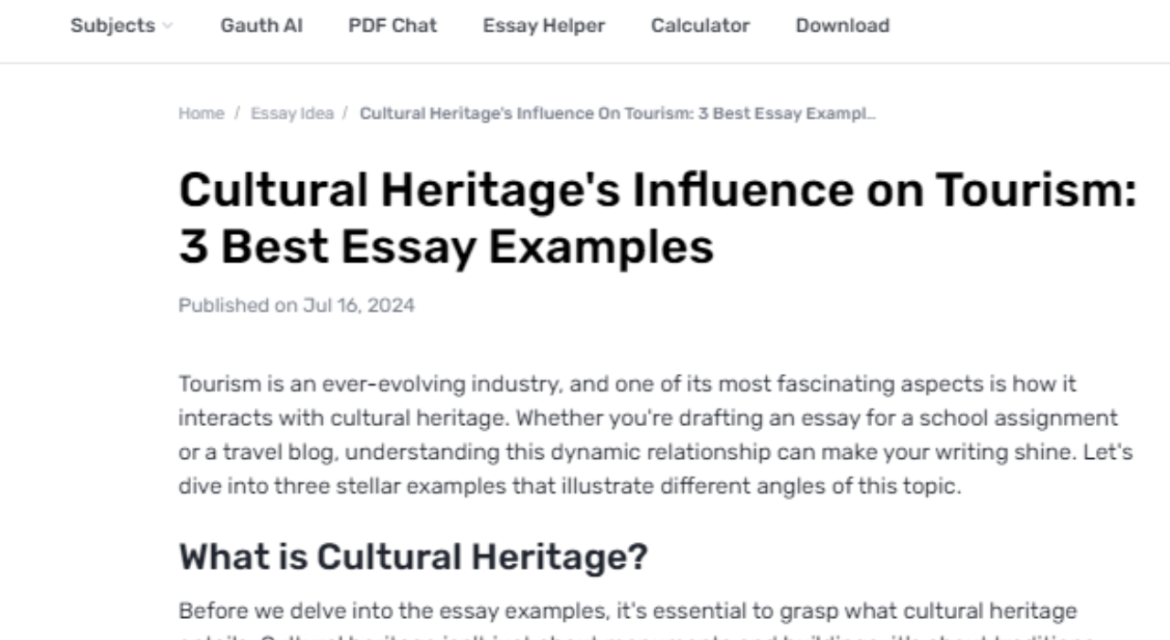Cultural heritage sites play a vital part in tourism development. These sites include authentic landmarks, ancient ruins, cultural celebrations, and conventional makes, acting as effective attractions for tourists around the world. By drawing visitors, they essentially boost the local economy through expanded income from tourism-related exercises such as convenience, feasting, and guided visits.
In addition, Cultural Heritage’s Influence on Tourism destinations cultivates a more profound social understanding among visitors, advancing appreciation and regard for assorted conventions and histories. Also, the popularity of these destinations emphasizes the significance of protecting social legacy, driving more prominent endeavors in preservation and security. Thus, cultural heritage destinations not only enhance the travel experience but also contribute to financial development and social conservation.
The Impact of Social Heritage Sites on Tourism Improvement
In this article, we will investigate the different ways in which cultural heritage sites impact tourism advancement. These sites boost nearby economies, advance social understanding, and energize the conservation of cultural heritage, playing a crucial part in attracting sightseers and cultivating economical tourism practices.
Fascination and Promotion of Tourism
Cultural heritage sites are frequently the essential attractions that draw tourists to a specific goal. Points of interest like the Awesome Wall of China, the Pyramids of Egypt, the Taj Mahal in India, and the Colosseum in Rome are notorious images that attract millions of guests annually. These locales offer special encounters that cannot be replicated somewhere else, making them profoundly alluring travel goals.
Financial Affect and Job Creation
The influx of visitors to social heritage destinations has a considerable financial effect on nearby communities. Tourism produces income through different channels, counting entrance expenses, guided visits, gift deals, convenience, and dining. This income not only bolsters the support and conservation of the destinations but also contributes to the broader economy. Besides, tourism improvement around cultural heritage locales leads to work creation.
Conservation and Preservation
The recognition of cultural heritage locales as important tourism resources frequently leads to expanded efforts in their conservation and preservation. Tourism income can be channeled into reclamation ventures, guaranteeing that these locales are kept up for future eras. Furthermore, the global consideration and awareness brought by tourism can lead to worldwide support and financing for preservation activities. Organizations such as UNESCO work to protect and protect world heritage sites, recognizing their significance not only to nearby societies but to the collective legacy of humanity.
Social Exchange and Understanding
Cultural heritage tourism encourages social trade and understanding between sightseers and local communities. Guests have the opportunity to memorize approximately the history, conventions, and way of life of the individuals within the locales they visit. This trade fosters common regard and appreciation, breaking down social obstructions and advancing worldwide solidarity.
Improvement of Infrastructure
The development of tourism infrastructure is regularly closely connected to cultural heritage destinations. To suit the influx of visitors, governments and private speculators may contribute to improving infrastructure such as streets, airports, open transportation, and utilities. Moreover, the request for convenience, dining, and entertainment choices leads to the development of hospitality and benefit businesses.
Promotion of Economical Tourism
Cultural heritage sites energize the advancement of maintainable tourism hones. Feasible tourism aims to minimize the negative impacts of tourism on the environment and neighborhood communities while maximizing its benefits. Efforts to secure and protect cultural heritage destinations regularly include economical practices, such as restricting guest numbers, advancing eco-friendly tourism exercises, and supporting local economies. Feasible tourism guarantees that social legacy locales can be delighted in by future eras while protecting their astuteness and realness.
Community Empowerment
The improvement of tourism around cultural heritage sites can engage nearby communities by giving them a sense of pride and possession of their social legacy. Local inhabitants can become effectively included in tourism exercises, such as giving guided visits, creating and offering conventional makes, and performing cultural moves and music. This interest not only gives financial benefits but also fortifies social personality and community cohesion.
Challenges and Considerations
Whereas the impact of cultural heritage destinations on tourism advancement is generally positive, there are challenges and considerations to address. Over-tourism can lead to the corruption of social legacy locales, causing physical harm and reducing their chronicled esteem. The commercialization of social legacy can also lead to the misfortune of realness and social centrality.
How to Use Gauth AI: The Perfect Study Friend
Achieve academic success with Gauth AI! Just write or submit your query, and our sophisticated AI will respond to it quickly. Gauth AI can handle any subject, including math and calculus, chemistry, biology, history, business, and writing. Our cutting-edge algorithms deliver precise answers in a matter of seconds.

Step 1: Enter Your Question Here
To get prompt assistance, type or upload your question.
Step 2: AI-Powered Remedies
Our strong AI precisely evaluates and resolves your issue.
Method by Method Advice: Adhere to precise, step-by-step instructions that clarify the “how” and “why” of every answer.
Step 3: Quick Results
Quickly get the answers you need to make your study sessions effective and fruitful.
Conclusion
Cultural heritage sites are effective drivers of tourism advancement. They attract guests from around the world, create financial benefits, advance social trade, and cultivate the conservation of social legacy. The improvement of tourism around these destinations leads to work creation, infrastructure enhancements, and community strengthening. Be that as it may, it is significant to address the challenges related to over-tourism and commercialization to guarantee that social legacy locales are protected for future eras.
